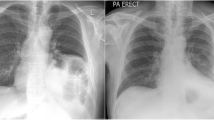Abstract
The objectives of this study were to examine the effects of anesthesia and implantation of sonomicrometer transducers on tonic and phasic expiratory activity of the abdominal muscles. Eight tracheotomized dogs were chronically instrumented with sonomicrometer transducers placed in each of the four abdominal muscles. The dogs were studied in the lateral decubitus position immediately after transducer implantation, while under halothane anesthesia, and then in the awake dogs 2 to 3 days postimplantation, and repeatedly over a 2- to 8-week period. The resting length (L RL) of the rectus abdominis (RA) was reduced in the first awake study compared to during anesthesia, but there was no change inL RL of the other abdominal muscles. The abdominal muscles phasically, actively, shortened during expiration more in the awake state than in the anesthetized state. The internal abdominal muscle layer (transversus abdominis and internal oblique) shortened phasically more than the external layer (RA and external oblique). Neither theL RL nor the amount of phasic shortening of the abdominal muscles changed significantly over the period in which transducers were in situ (2–8 weeks). Muscle sections excised at the end of each study exhibited small capsules of fibrosis immediately surrounding the transducers with normal muscle tissue between pairs of transducers. In conclusion, both tonic and phasic respiratory activity of the abdominal muscles, reflected by changes in resting length and the amount of active shortening, respectively, were absent during halothane anaesthesia and chronic implantation of sonomicrometer transducers per se had no effect.
Similar content being viewed by others
References
De Troyer A, Ninane V (1987) Effect of posture on expiratory muscle use during breathing in the dog. Respir Physiol 67: 311–322
Easton PA, Fitting JW, Arnoux R, Gueraty A, Grassino AE (1989) Recovery of diaphragm function after laparotomy and chronic sonomicrometer implantation. J Appl Physiol 66(2): 613–621
Farkas GA, De Troyer A (1989) Effects of midline laparotomy on expiratory muscle activation in anesthetized dogs. J Appl Physiol 67(2): 599–605
Farkas GA, Schroeder MA (1990) Mechanical role of expiratory muscles during breathing in prone anesthetized dogs. J Appl Physiol 69(6): 2137–2142
Fitting JW, Easton PA, Arnoux R, Gueraty A, Grassino AE (1987) Effect of anesthesia on canine diaphragm length. Anesthesiology 66: 531–536
Fregosi RF, Knuth SL, Ward DK, Bartlett D, Jr. (1987) Hypoxia inhibits abdominal expiratory nerve activity. J Appl Physiol 63(2): 211–220
Freund F, Roos A, Dodd RB (1964) Expiratory activity of the abdominal muscles in man during general anesthesia. J Appl Physiol 19(4): 693–697
Froese AB, Bryan AC (1974) Effects of anesthesia and paralysis on diaphragmatic mechanisms in man. Anesthesiology 41: 242–255
Gold MI, Helrich M (1965) Mechanics of breathing during anesthesia. 2: The influence of airway adequacy. Anesthesiology 26: 751–762
Kaul SU, Heath JR, Nunn JF (1973) Factors influencing the development of expiratory muscle activity during anaesthesia. J Anaesth 45: 1013–1018
Leevers AM, Road JD (1989) Mechanical response to hyperinflation of the two abdominal muscle layers. J Appl Physiol 66(5): 2189–2195
Leevers AM, Road JD (1993) Effects of posture on abdominal muscle shortening in awake dogs. J Appl Physiol 75: 1452–1459
Muller N, Volgyesi G, Becker L, Bryan MH, Bryan AC (1979) Diaphragmatic muscle tone. J Appl Physiol 47: 279–284
Newman SL, Road JD, Bellemare F, Clozel JP, Lavigne CM, Grassino AE (1984) Respiratory muscle length measured by sonomicrometry. J Appl Physiol 56: 753–764
Ninane V, Gilmartin JJ, De Troyer A (1988) Changes in abdominal muscle length during breathing in supine dogs. Respir Physiol 73: 31–42
Oliven A, Kelsen SG (1989) Effect of hypercapnia and PEEP on expiratory muscle EMG and shortening. J Appl Physiol 66(3): 1408–1413
Rehder K, Marsh HM (1986) Respiratory mechanics during anesthesia and mechanical ventilation. In: Macklem PT, Mead J (eds) Handbook of physiology section 3: The respiratory system, vol. III. Williams & Wilkins, Baltimore, MD, pp 737–743
Sant’Ambrogio G, Widdicombe JG (1965) Respiratory reflexes acting on the diaphragm and inspiratory intercostal muscles of the rabbit. J Physiol (London) 180: 766–779
Skatrud JB, Dempsey JA, Badr MS, Begle RL (1988) Effect of airway impedance on CO2 retention and respiratory muscle activity during NREM sleep. J Appl Physiol 65(4): 1676–1685
Southorn P, Rehder K, Hyatt RE (1980) Halothane anesthesia and respiratory mechanics in dogs lying supine. J Appl Physiol 49(2): 300–305
Torres A, Kimball WR, Qvist J, et al. (1989) Sonomicrometric regional diaphragmatic shortening in awake sheep after thoracic surgery. J Appl Physiol 67(6): 2357–2368
Wakai Y, Welsh MM, Leevers AM, Road JD (1992) Expiratory muscle activity in the awake and sleeping human during lung inflation and hypercapnia. J Appl Physiol 72(3): 881–887
Yasuma F, Kimoff RJ, Kozar LF, England SJ, Bradley TD, Phillipson EA (1993) Abdominal muscle activation by respiratory stimuli in conscious dogs. J Appl Physiol 74(1): 16–23
Younes M, Youssef M (1978) Effect of five human anesthetics on respiratory control in cats. J Appl Physiol 44(4): 596–606
Author information
Authors and Affiliations
Rights and permissions
About this article
Cite this article
Leevers, A.M., Road, J.D. The effect of anesthesia on abdominal muscle resting length and shortening in awake dogs. Lung 173, 105–115 (1995). https://doi.org/10.1007/BF02981470
Accepted:
Issue Date:
DOI: https://doi.org/10.1007/BF02981470




